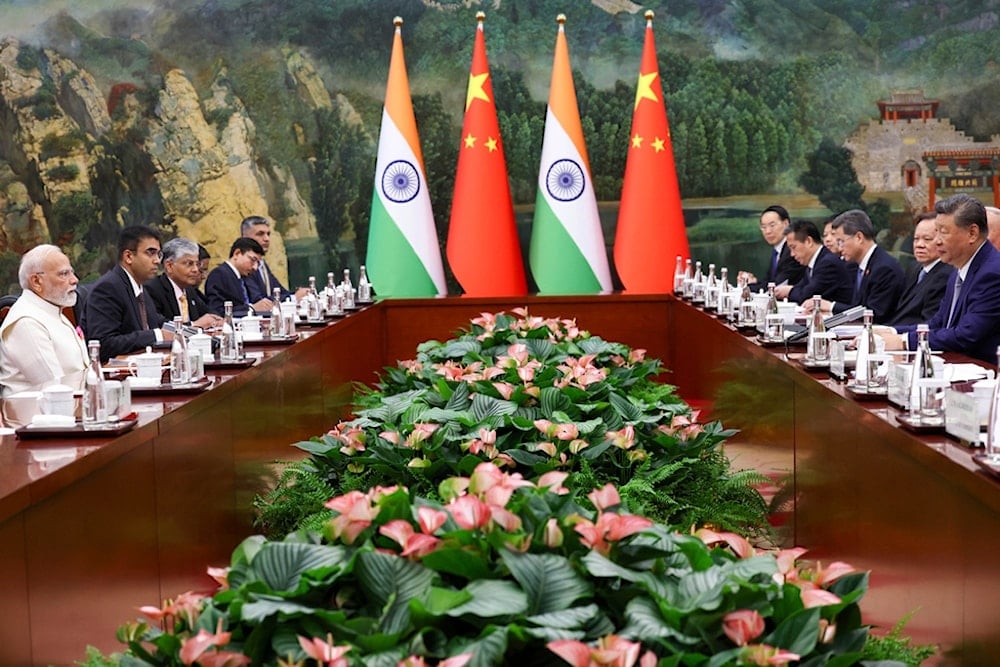Trump tariffs hit India, push Modi toward closer China ties: NYT
Trump’s 50% tariffs have shaken India’s economy and manufacturing hopes, NYT reports, pushing Modi to weigh deeper trade ties with China.
-

Indian Prime Minister Narendra Modi, left, and Chinese President Xi Jinping, right, hold a meeting on the sidelines of the SCO summit in Tianjin, China, Sunday, August 31, 2025. (Indian Prime Minister's Office via AP)
US President Donald Trump’s decision to impose 50% tariffs on Indian imports has landed like “a declaration of economic war,” unraveling India’s hopes of becoming the world’s preferred manufacturing alternative to China, The New York Times reported.
According to the NYT, the tariffs struck at the heart of India’s China Plus One strategy, which business leaders and global financiers had embraced as a hedge against overdependence on Chinese factories. Within days of the tariffs taking effect, officials in New Delhi and US investors were left reeling, trying to adapt to a dramatically altered trade landscape.
The timing of the tariffs coincided with Prime Minister Narendra Modi’s first trip to China in seven years, where he met President Xi Jinping. While relations between India and China have often been tense, marked by deadly border clashes and economic rivalry, the NYT noted that Trump’s economic measures may push India toward greater coordination with Beijing.
For Modi, the blow is severe. Manufacturing growth was seen as a solution to underemployment for millions of young Indians and as a pathway to lifting India into the ranks of the top three global economies. Now, without US support, and with multinationals reconsidering their supply chains, that goal has become harder to reach.
Business fallout, supply chain rupture
Economists quoted by The New York Times warned that the “Trump shock” would kill off early signs of export growth and investment. Four Indian economists, including a former chief economic advisor to Modi, argued in an Indian newspaper that the tariffs could devastate India’s fragile progress.
The NYT detailed how the tariffs are already straining Indian industries. Companies that supply the US market now face bleak prospects, with importers turning instead to Vietnam, Mexico, or other tariff-free markets. A US court ruling that questioned the legality of the tariffs did little to ease concerns, as the measures remain in force while Trump appeals.
Business owners told the newspaper they felt betrayed after years of building partnerships with US companies. In Moradabad, a hub for handicrafts and light industry, factory manager Samish Jain said his firm exported 40% of its goods to America. “Most people are still in shock,” Jain told the paper, adding that he was scrambling to find buyers in Europe, the Middle East, or India itself. “We can’t just let people go,” he said of his longtime workers.
India-China dilemma
The report also noted that even before Modi’s trip, India and China were exploring ways to reopen direct flights and cross-border trading posts. Though no joint agreements were announced in Tianjin, officials said both sides planned to expand bilateral trade and investment ties.
Still, the relationship is complicated. India has, in recent years, restricted Chinese venture capital, banned more than 200 Chinese apps, and tightened visa access for investors, citing national security concerns. China, meanwhile, has used its dominance in rare earths and other technologies to exert pressure on India, creating what experts described to the NYT as structural vulnerabilities.
Analyst Santosh Pai told the paper that China controls 134 industrial categories critical to Indian industry. “China has progressively weaponized everything,” he said, noting how deeply dependent India remains on its rival for imports.
Fragile balancing act
Despite these tensions, the NYT said that Modi’s government may have little choice but to welcome some forms of Chinese investment, particularly in technology, as the $129 billion in trade with the United States falters. Pai argued that India would even be “grateful” for certain Chinese inflows because they could provide jobs at a time of mounting economic pressure.
China, for its part, is eager to invest in India. But whether national security concerns will allow Modi to fully embrace Beijing’s capital remains uncertain.
As The New York Times concluded, India’s position between its two largest trading partners has never been more precarious. The tariffs from Washington, combined with Beijing’s leverage over critical supply chains, have left New Delhi squeezed on both sides.
“If this were a love triangle, India would be the jilted lover,” the newspaper wrote, noting that Trump’s economic weaponization has cast a shadow over Modi’s diplomatic overtures to Xi. For now, India must reconcile its ambition to rival China in manufacturing with the reality that both Washington and Beijing hold the keys to its economic future.

 4 Min Read
4 Min Read








